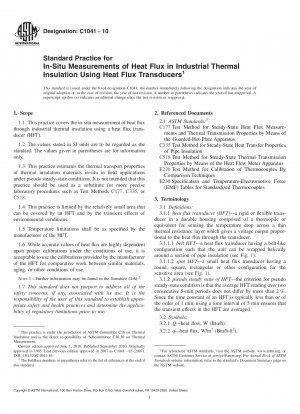ASTM C1041-10
Standard Practice for In-Situ Measurements of Heat Flux in Industrial Thermal Insulation Using Heat Flux Transducers
- Standard No.
- ASTM C1041-10
- Release Date
- 2010
- Published By
- American Society for Testing and Materials (ASTM)
- Latest
- ASTM C1041-10
- Scope
The major contribution of this practice is that it enables a measurement of the real-time energy loss or gain through a chosen surface of an existing process insulation with minimal disturbance to the heat flux through the insulating body.
The primary use of this practice will be for the in-situ estimation of thermal transport properties of industrial insulation such as used on pipes, tanks, ovens, and boilers, operating under normal process conditions.
Errors attributable to heat flow measurements over a small area or short term testing can be misleading and this practice is intended to minimize such errors.
Insulation processes with large temperature differences across the insulation are best suited to HFT measurements because modest changes in ambient conditions have but minimal effects on HFT output.
While it would be ideal for the HFT and attachment system to have zero thermal resistance, this factor is insignificant to the measured result if kept to 5 % or less of the resistance of the insulating section being tested.
1.1 This practice covers the in-situ measurement of heat flux through industrial thermal insulation using a heat flux transducer (HFT).
1.2 The values stated in SI units are to be regarded as the standard. The values given in parentheses are for information only.
1.3 This practice estimates the thermal transport properties of thermal insulation materials in-situ in field applications under pseudo steady-state conditions. It is not intended that this practice should be used as a substitute for more precise laboratory procedures such as Test Methods C177, C335, or C518.
1.4 This practice is limited by the relatively small area that can be covered by an HFT and by the transient effects of environmental conditions.
1.5 Temperature limitations shall be as specified by the manufacturer of the HFT.
1.6 While accurate values of heat flux are highly dependent upon proper calibrations under the conditions of use, it is acceptable to use the calibrations provided by the manufacturer of the HFT for comparative work between similar materials, aging, or other conditions of use.
Note 18212;Further information may be found in the literature (1-6).
1.7 This standard does not purport to address all of the safety concerns, if any, associated with its use. It is the responsibility of the user of this standard to establish appropriate safety and health practices and determine the applicability of regulatory limitations prior to use.
ASTM C1041-10 Referenced Document
- ASTM C177 Standard Test Method for Steady-State Heat Flux Measurements and Thermal Transmission Properties by Means of the Guarded-Hot-Plate Apparatus
- ASTM C335 Standard Test Method for Steady-State Heat Transfer Properties of Horizontal Pipe Insulation
- ASTM C518 Standard Test Method for Steady-State Thermal Transmission Properties by Means of the Heat Flow Meter Apparatus
- ASTM E220 Standard Test Method for Calibration of Thermocouples By Comparison Techniques
- ASTM E230 Standard Specification and Temperature-Electromotive Force (EMF) Tables for Standardized Thermocouples
ASTM C1041-10 history
- 2010 ASTM C1041-10 Standard Practice for In-Situ Measurements of Heat Flux in Industrial Thermal Insulation Using Heat Flux Transducers
- 2007 ASTM C1041-85(2007) Standard Practice for In-Situ Measurements of Heat Flux in Industrial Thermal Insulation Using Heat Flux Transducers
- 1985 ASTM C1041-85(2001) Standard Practice for In-Situ Measurements of Heat Flux in Industrial Thermal Insulation Using Heat Flux Transducers
- 1985 ASTM C1041-85(1995)e1 Standard Practice for In-Situ Measurements of Heat Flux in Industrial Thermal Insulation Using Heat Flux Transducers
